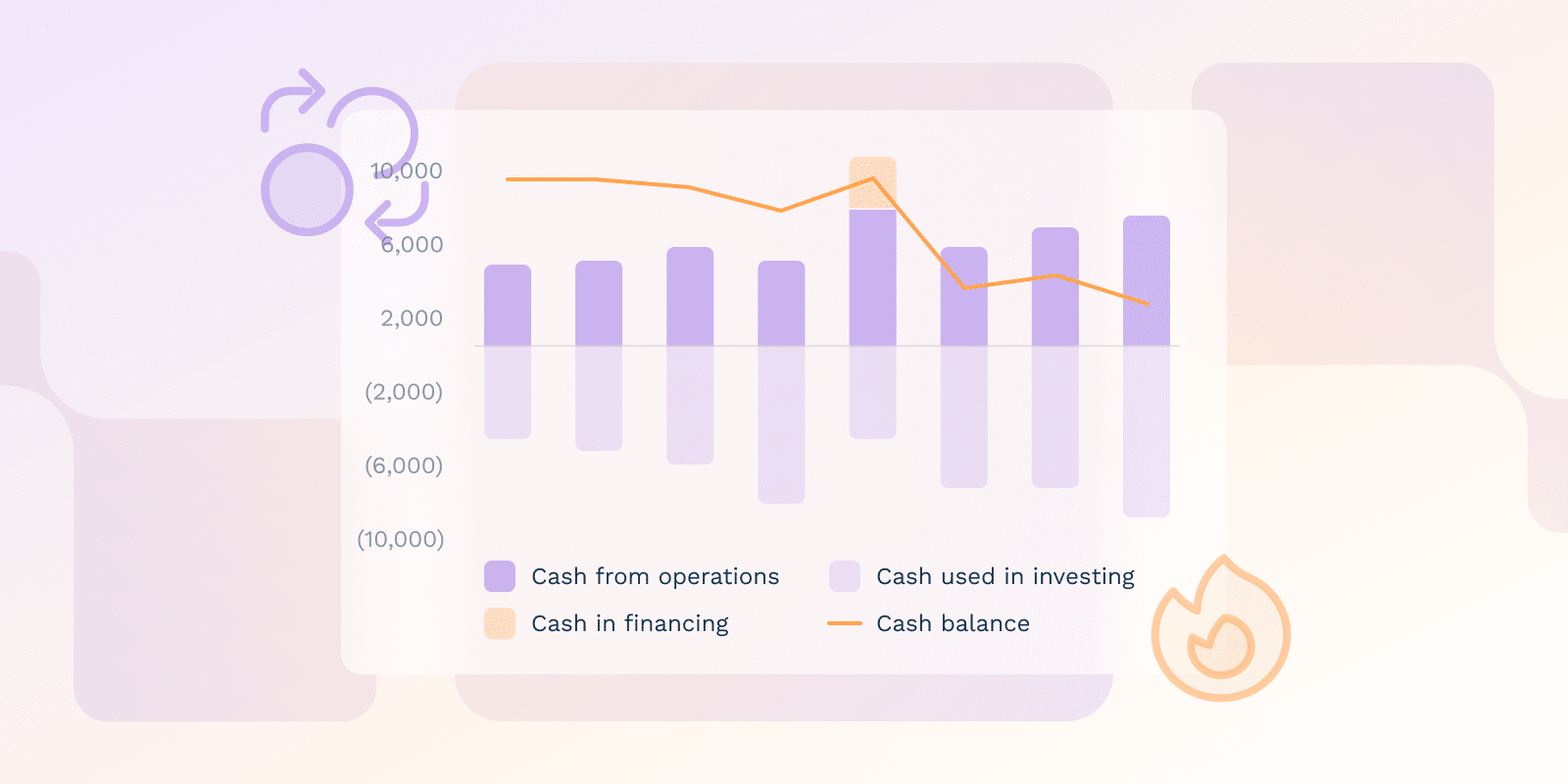Metriche e KPI SaaS
Cos'è il tasso di consumo?

Cos'è il tasso di combustione?
Il tasso di combustione è la velocità con cui un'organizzazione gestisce le proprie finanze prima di raggiungere il punto di pareggio o di operare con un profitto. Questa metrica è particolarmente vera per le start-up e le nuove imprese che non stanno ancora guadagnando o pareggiando i costi sostenuti.
Sapere per quanto tempo dureranno le riserve di cassa della tua azienda è essenziale per prevedere correttamente le esigenze di cassa. Il tasso di consumo spesso rivela informazioni sulla salute finanziaria di un'azienda. Mentre un alto tasso di consumo può suggerire un potenziale rischio finanziario, un tasso basso potrebbe indicare una crescita limitata.
Come viene calcolato il tasso di consumo?
Nel calcolare il tasso di consumo, stabilisci i saldi di cassa iniziali e finali per un periodo di tempo, come un mese.
In secondo luogo, prendi il saldo di cassa dell'ultimo giorno del periodo, sottrailo dal saldo di cassa del primo giorno del periodo e dividi il numero di mesi nel periodo.
Considera il caso in cui un'azienda deve iniziare un mese con $ 100.000 e finirlo con $ 80.000. Il tasso di consumo mensile è quindi 20.000, ovvero ($ 100.000 - $ 80.000) / 1 mese = 20.000.
Ricorda che ci sono due tipi di burn rate. Il burn rate lordo include tutte le spese operative per un determinato periodo, mentre il burn rate netto viene calcolato dopo aver dedotto tutti i costi operativi.
Quali fattori chiave influenzano il burn rate di un'azienda?
Il burn rate è un periodo o una velocità con cui un'organizzazione spende le proprie riserve, solitamente misurato in mesi o settimane, a seconda del tasso di spesa. Considera i seguenti fattori:
- Durante l'espansione, un'azienda controlla il burn rate considerando le dimensioni dell'azienda, il tasso di crescita, le spese, la provenienza delle entrate, l'afflusso di cassa e altri fattori esterni.
- Considera la generazione di entrate poiché determina quanto velocemente le risorse di un'azienda possono essere ripristinate.
- Le spese amministrative generali e altre implicazioni del finanziamento, come il rimborso dei prestiti, hanno un impatto considerevole sui calcoli relativi al tasso di combustione complessivo e non dovrebbero essere trascurate.
- La gestione delle spese eccessive è essenziale per raggiungere una sostenibilità prudente a lungo termine, riducendo i potenziali impatti negativi sui progressi aziendali.
Qual è l'importanza del tasso di combustione per investitori e stakeholder?
Il monitoraggio del tasso di combustione fornisce agli stakeholder preziose informazioni sulla salute finanziaria dell'organizzazione, in particolare sulla quantità di risorse liquide disponibili.
Comprendendo la quantità di rischio associata all'investimento nell'azienda, nonché il tasso di spesa sulla disponibilità di cassa, il tasso di combustione aiuta a determinare quali risorse sono disponibili per supportare l'azienda.
Con questa metrica, viene determinato per quanto tempo un'organizzazione può rimanere operativa e raggiungere pareggio senza realizzare profitti o ricevere ulteriori finanziamenti.
Qual è un buon tasso di burn rate?
Il calcolo del burn rate include l'identificazione della crescita negativa e del tasso di perdita. Un burn rate ideale rivela quanto velocemente un'organizzazione esaurisce le proprie risorse di cassa senza andare fuori mercato.
Nel caso delle aziende SaaS, un tasso di burn rate sano è in genere quando un'azienda può ancora acquisire clienti pur avendo un afflusso di cassa stabile dagli abbonati. Un tasso di burn rate netto negativo, che indica un flusso di cassa positivo dell'azienda, è un indicatore finanziario che gli investitori possono considerare quando valutano il suo gestione finanziaria. e capacità.
Per garantire una sana gestione finanziaria, la direzione dovrebbe adottare un approccio cauto all'utilizzo della cassa ed evitare raccolte fondi non necessarie.
| Fase aziendale | Caratteristiche tipiche del Burn Rate | Implicazioni finanziarie |
|---|---|---|
| Fase di startup | ||
| Startup in fase iniziale | Burn rate elevato, entrate limitate | Elevati investimenti, flusso di cassa negativo |
| Seed/Pre-Revenue | Spesa aggressiva per lo sviluppo del prodotto | Dipendente dai finanziamenti degli investitori |
| Fase di crescita | ||
| SaaS in crescita | Tasso di consumo moderato con entrate crescenti | Bilanciamento tra acquisizione clienti e conservazione di liquidità |
| SaaS affermato | Tasso di consumo controllato con flussi di entrate stabili | Flusso di cassa positivo, operazioni sostenibili |
| Fase di maturità | ||
| Azienda matura | Basso tasso di consumo, spese prevedibili | Forti riserve di liquidità, potenziale di reinvestimento |
| Leader di mercato | Tasso di consumo minimo, entrate diversificate | Spesa strategica, flessibilità finanziaria |
Come possono le aziende spendere il loro tasso di combustione in modo produttivo?
Tieni traccia dei costi sostenuti dall'organizzazione e rendiconta regolarmente le attività finanziarie. Esamina attentamente le spese per determinare cosa dovrebbe essere ridotto o migliorato. Trova modi per aumentare le entrate, come eseguire il finanziamento dei crediti, spendere meno del budget operativo dell'azienda e interrompere le filiali dell'azienda a bassa redditività.
Pianificazione operativa e approcci di previsione potrebbero aiutare a semplificare la gestione del tasso di combustione, anche se i risultati possono variare.
Conclusione
Misurare il tasso di consumo fornirà informazioni sulla salute finanziaria e sul rischio di un'azienda. Poiché misura la velocità con cui l'azienda utilizza le sue riserve di cassa, è importante per la pianificazione. Considerare le dimensioni dell'azienda, le spese, le entrate e il tasso di crescita quando si esamina questa metrica. Gestire il tasso di consumo non è una garanzia di successo, ma mostra il potenziale per la longevità e l'espansione.